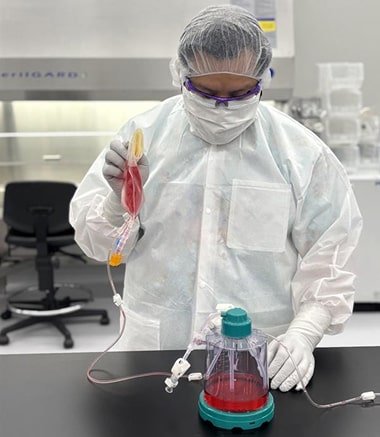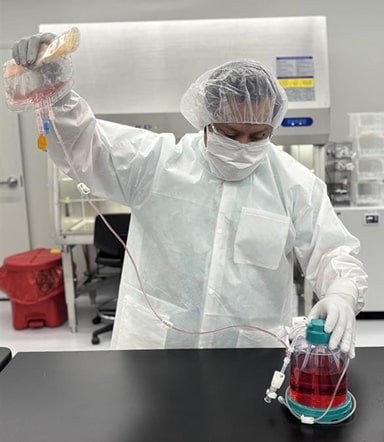80-90% of CAR-T cell therapy manufacturing can be standardized and nearly 100% of the CAR-T cell therapy manufacturing can be further simplified. We believe this is necessary for the industrialization of CAR-T to a level where advanced therapies are delivered just-in-time to all patients.
CellReadyTM, the world’s first and only G-Rex(R) based contract development and manufacturing (CDMO), is currently in process and analytical development of G-CAR-T, a simplified and standardized method for assembling CAR-T cell drug product.
Day -1
Preparation & T-Cell Isolation
The process begins with the patient’s leukapheresis material, focusing on isolating and qualifying T cells. This stage establishes starting-material purity, viability, and documentation to enable a consistent, high-quality drug product.
Key Steps:
- Apheresis is received, quarantined, and documented.
- Apheresis is positively enriched for CD4+ & CD8+ T cells
- Aliquots of 2×108 purified T cells are frozen and put into inventory
Design Space:
- All commercially available instruments can be used to enrich for CD4+ & CD8+ T cells
- Positively or negatively isolated CD3+ cells is also compatible
- Non-instrument based methods for isolating T cells is currently in development
Day 0
Activation and Genetic Modification
The key manufacturing day when patient T cells are activated and transduced to express the CAR, establishing the genetic program that enables precise tumor recognition and cytotoxicity.
Key Steps:
- Purified T cells are thawed and diluted in 50mL complete culture media
- A 50mL “mastermix” containing activation and lentiviral particles is added to the isolated T cell suspension
- A G-Rex100M-CS is inoculated with the 100mL solution
- Seeding Density (cells/cm2) between 1-2×106 cells/cm2
- Seeding Concentration (cells/mL) between 1-2×106 cells/mL
- MOI between 5-10
- The G-Rex100M-CS is incubated for 72 hours at 37C and 5% CO2
Design Space:
- All commercially available activation reagents (both soluble and insoluble) are compatible
- Immobilization of antibodies (on a RetroNectin coated membrane) for activating from bulk PBMCs is also compatible
Day 3
Expansion
Key Steps:
The genetically modified cells need to be replicated (cultured) to larger quantities sufficient to make a therapeutic dose and media tumor regression.
- 900mL of complete medium is gravity drained into G-Rex100M-CS. Complete media is formulated by combining:
- Basal media (CCM038)
- 5% human AB serum
- IL-7 (10ng/mL)
- IL-15 (10ng/mL
The G-Rex100M-CS is placed into a static incubator for culture until Day 7 when the CAR-T cells will be ready to harvest.

An operator performs a sterile weld and gravity drains 900mL of complete media into the G-Rex100M-CS outside of the biosafety cabinet in ISO 8 cleanroom.

A few minutes later the G-Rex100M-CS is brought to full volume. The media bag will be sterily disconnected through a heat seal and the G-Rex100M-CS will incubate the drug substance, undisturbed, in a standard incubator.
Design Space:
- All commercially available medias and cytokines are compatible
- Different cytokine combinations (including IL-2 or IL-21) are compatible
Day 7
Harvest and Final Product Formulation
Once CAR-T cells have achieved the target therapeutic dose, they are now harvested and processed into a final drug product suitable for clinical administration.
Key Steps:
- The G-Rex100M-CS is volume reduced with the GatheRex (80000E), the conditioned media is pushed into a 1L bioprocessing bag (WW-SV1L444), and the drug substance is concentrated in the remaining 100mL.
- The CAR-T cells are harvested into a 250mL bioprocessing bag (WW-FP250ML), washed, and formulated using 10% DMSO into the final drug product

The GatheRex uses positive air pressure to remove 90% of the conditioned media thereby concentrating the cells from 3-4×10^6 cells/mL to 30-40×10^6 cells/mL.
This log-fold concentration reduces the time and labor burden downstream during formulation dramatically
Design Space:
- For formulation and fill/finish, all commercially available approaches are compatible.
- To reduce the cycle time when concentrating larger volumes, the volume reduction can be done using the large diameter C-Flex tubing and the GatheRex (80000Z).
Frequently Asked Questions
What are my critical process parameters with G-CAR-T?
With the exception of critical process parameters related to the mechanized movement of fluid (e.g. flow velocity, sheer, agitation rate), all other critical process parameters will generally be the same.
- Number & nature of cells seeded into G-Rex must be strictly controlled
- Reagent concentrations, volumes, and temperatures must be strictly controlled
- Cell culture media formulation must be strictly controlled
- Length & cycle time of all unit operations must be strictly controlled
- Hold times between unit operations must be strictly controlled
- Instruments used must be strictly controlled through proper IQ/OQ/PQ procedures
- Formulation conditions must be strictly controlled
What is the per batch cost of CAR-T drug product produced through G-CAR-T?
The per batch cost of CAR-T drug product produced through G-CAR-T will vary depending on a number of factors (mainly the throughput/capacity requirements).
Nonetheless, G-CAR-T will require the smallest overhead and will deliver the highest throughput, rendering G-CAR-T as the most economical method for manufacturing drug product.
What methodology drives G-CAR-T development?
G-CAR-T development is done through Quality by Design (QbD) rather than through the Scientific Method.
Fundamentally, G-CAR-T begins with the end in mind and takes the final assembly line as the starting point, moving backwards from there.
All upstream processes serve the final downstream process such that manufacturing advanced therapies just-in-time for all patients is possible.
The result is an extremely simple, robust, and repeatable approach that will democratize access to equitable CGT manufacturing.
How does G-CAR-T compare to other production systems?
G-CAR-T is an assembly line approach to manufacturing drug product that is juxtaposed to an alternative approach utilizing “mechanized” bioreactors.
The modular nature of G-CAR-T means that the bottleneck is always the longest cycle time in a chain of dependent unit operations. For example, the cycle time of T cell isolation is a bottleneck. If one T cell isolation machine (e.g. CliniMACS Plus or Dynaselect) requires two (2) hours to set up, run, and take down, then this becomes a rate limiting step and a bottleneck in the process. Essentially, every 2 hours a new apheresis product could undergo T cell isolation and move into the next unit operation.
Is G-CAR-T an automated workflow?
Certain elements of the G-CAR-T workflow are automated and some are automatic.
Examples of automated elements of G-CAR-T include:
- automated cell washing & buffer exchanges
- automated volume reduction and harvest
- automated cell counting and QC analysis
Examples of automatic elements of G-CAR-T include:
- automatic delivery of oxygen (in standard incubator)
- automatic delivery of nutrients (in standard incubator)
- automatic dilution of waste (in standard incubator)
Moreover, the entire assembly and sub-assembly procedures are very simple and highly repeatable enabling this entire workflow to be robotically autonomated for “lights off” end-to-end automated manufacturing.
